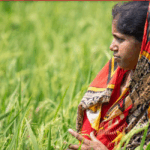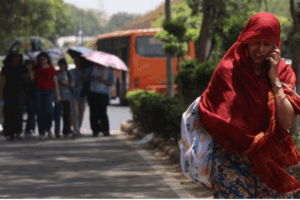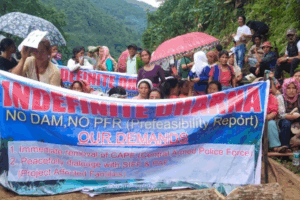PJ James
The following study shows how the numerous projects of Coal Based Methane are started in 12 states affecting the land, livelihood of millions of families and environment of vast areas. Though spontaneous struggles are taking place against these in some places, so far they have not developed in to a major people’s resistance. But the CBM project started in Kaveri basin affecting vast agricultural fields of fertile Kaveri Delta is already opposed by large number of people and organizations. CPI(ML) Red Star state committee of TN has decided to intervene to intensify the movement. In this context, report from different states are called for on the CBS projects in the states and people’s reaction to them, including the possibilities to develop movements against this environmental onslaught — Red Star
Introduction
Interest in Coal Bed Methane (CBM), an unconventional source of natural gas as an alternative source for India’s energy requirements needs to be evaluated in the broader context of the search for extractive industries and land resources along with financial speculation as quick-fix solution for corporate wealth accumulation in the neoliberal period. India having the fifth largest proven coal reserves in the world now holds significant prospects for exploration and exploitation of CBM that is estimated at about 92 TCF (trillion cubic feet) spread across 12 states in the country. It was the UF government in 1997 that formulated a CBM Policy under the auspices of Ministry of Petroleum & Natural Gas (MOP&NG) for harnessing the vast CBM potential in the country. CBM exploration and drilling in India got added impetus during the UPA regime and the Modi government that is bent on filling corporate coffers, instead of seeking eco-friendly renewable energy sources, is boosting the CBM project with intensified vigour.
Today more than a dozen CBM exploration and drilling companies, both foreign and domestic, are active in gas extraction in India. Among them, Essar, the London-based hydro-carbon giant is the biggest explorer and producer of CBM in the country. Essar, as per agreement with MOP&NG, now controls high quality acreages of around 2700 sq km spread across the States of Odisha, Jharkhand, Madhya Pradesh and Chhattisgarh for exploration and production of CBM estimated at 6 TCF in addition to its East Raniganj flagship CBM project in West Bengal. Essar which has been active in the field for almost a decade and the first company in India to cross CBM production at the rate of 1 million scmd (standard cubic meters per day) has already invested Rs. 3300 crores in Raniganj (East) Block. There the target was to produce 2 million scmd by 2016-17 and 3 million scmd by the end of the financial year 2017-18. The East Raniganj Block has sizeable CBM reserves estimated at 1.09 TCF with 25-30 years of field life as per the 2016 reserve report from Netherland Sewell & Associates (NSAI), one of the famous CBM exploration consultants in the world. From 350 wells in the beginning, Essar envisages to extend its drilling and fracking operations to 2 million wells in Raniganj by mid 2017-18 when production is expected to reach a plateau of 3 million scmd. A study undertaken with the support of US Trade & Development Agency (USTDA) by US specialists with expertise in shale has an assessment of original in-place shale gas resources of around 8 TCF underneath the CBM plate in Raniganj (East) Block.
Among others active in the field, another corporate player in CBM extraction in Raniganj (South block) since 2007 is Great Eastern Energy Corporation Ltd (GEECL) owned by YK Modi Holding Group, a private financial company based in Gurgaon, Haryana, listed in the London Stock Exchange. Its license area in Raniganj South covers 210 sq. km. (52500 acres) encompassing around 300 wells. Having franchisee agreements with Indian Oil Corporation Limited and Bharat Petroleum Corporation Limited for the supply of compressed natural gas (CNG), the GEECL pipeline of 77.62 km runs through the heart of Asansol-Durgapur industrial belt in West Bengal.
Even though Essar is the largest player in the field of CBM, GEECL has been the first company in India to commercially produce natural gas from coal beds in West Bengal. Now with its experience from West Bengal, it is the GEECL that has been trying to establish a wholly owned CBM project in Mannargudi block in Tamil Nadu. GEECL also claims to have the required environmental clearance there.
Beginnings of Methane Project in Kaveri Basin
It was during the UPA regime that following the approval by the Cabinet Committee of Economic Affairs in 2009, the ONGC sunk two 4000-feet wells at Neduvasal, a village in Pudukottai for hydrocarbon (all organic compounds consisting entirely of carbon and hydrogen are called hydrocarbon; it is the generic name given to fossil fuels including petrol and diesel; methane – CH4 – is also a hydrocarbon) exploration and extraction project. Later, the ONGC has sunk 31 places at Pudukotai and found that several villages in these areas have hydrocarbon resources and this led to the display of green signal for the hydrocarbon extraction from Kavery delta in Tamil Nadu.
The Kaveri delta CBM extraction project that got sanction in 2009 was a project to extract methane gas from coal-bed by using hydraulic fracturing in the Kaveri river basin in Tamil Nadu. The then Manmohan government through the Ministry of Petroleum and Natural Gas arrived at a production sharing agreement with the GEECL for CBM extraction from Mannargudi block of Thiruvarur district in the Kaveri basin in 2010. In 2011, the Tamil Nadu government entered in to a MoU with the GEECL granting permission, licenses and necessary infrastructures to the company for pursuing the project. Accordingly, GEECL received license to explore and extract CBM from Nagapattinam, Thanjavur and Thiruvarur districts which are the major rice cultivating area of Tamil Nadu. Of course, it was the then DMK government of Tamil Nadu that issued Petroleum Extraction License (PEL) to GEECL for an area covering 667 sq km with a volume of 0.98 TCF gas spread across Nagapattinam, Thanjavur and Thiruvarur districts. Subsequently, the Union Ministry for Environment and Forests (MOEF) also issued environmental clearance to the project.
When news broke out about this project, farmers, environmentalists, intellectuals and even well-meaning petro-chemical experts started protests opposing the project and various political parties came in support of the movement and the issue was debated in parliament too. After returning to power in 2011, Jayalalitha took the unusual step of cancelling the MoU with GEECL and the CBM project stood cancelled for the time being. The Tamil Nadu government decision cancelling the project was based on an Expert Committee report constituted by the government. This expert committee was comprised of representatives from Anna University, the Indian Institute of Technology, Madras, the Tamil Nadu Agricultural University and the MS Swaminathan Research Foundation, and officials from the Public Works Department, the Tamil Nadu Pollution Control Board and Tamil Nadu Industrial Development Corp.
However, things got a new turn with the ascendancy of corporate-sponsored ultra-rightist Modi government in mid 2014. Along with the revival of the erstwhile GEECL project in the Mannargudi area, Reliance, the largest Indian corporate company specialized in hydrocarbon extraction from KG-basin also started showing particular interest in the Methane exploration project in Tamil Nadu. With an investment of Rs. 800 crores, Reliance has drilled nine wells and discovered hydrocarbons in three wells till date. The Government Notification issued in October 2014 and the Hydrocarbon Exploration Licensing Policy (HELP) announced in March 2016 by the Modi regime at the behest of corporate CBM extractors assumed multi-dimensional character as both allow private companies to explore and produce all types of hydrocarbons together with CBM from their area of operation. Despite growing protests and agitations from peasants and common people who saw the methane project as serious threat to their food security, livelihood, sustenance and environment, the Union Ministry of Environment and Forests in gross disregard of the earlier Expert Committee study has once again came forward granting clearance for the project without any proper EIA study.
Impact of CBM Extraction on Habitat and Environment
In fact, the Expert Committee appointed by the Tamil Nadu government in its Report had highlighted the harmful consequences arising from a CBM project. At the outset it is to be stated that methane (CH4) which can be compressed and marketed as CNG as a substitute to conventional natural gas and therefore now projected as the “miracle gas” for India’s development by pro-market forces is a poisonous gas for all living beings and its toxicity is estimated at around 100 times that of carbon dioxide (CO2). The “green house gas” effect of methane is several times higher than that of carbon dioxide. Even under efficient control mechanisms, along with methane, huge amount of sulphides and oxides of hydrogen and nitrogen and other poisonous gases and pollutants will be emitted from the drilling and refining sites in addition to usual emissions from diesel generators and trucks which will be in constant use. Along with such toxic emissions which contaminate everything including soil, water and air, noise pollution and light pollution arising from continuous burning of unwanted gases are potential threats to humans, animals and plants.
Most crucial repercussion arising from a CBM project, especially in a “dry region” like Tamil Nadu will be its impact on ground-water. Previous experiences from CBM extraction sites show that continuous pumping out of ground water trapping the methane is a must for the release of it from the coal bed. Such incessant removal and disposal of water trapped above coal beds will result in the eventual depletion of ground water along with lowering of water flow levels in wells, rivers and streams. Hence the ultimate outcome of a CBM extraction in a place like Tamil Nadu will be desertification of the entire area.
The direct impact of methane on drinking water will be horrific. The hydraulic fracturing that releases methane from coal seams directly pollutes water through leakages. It is estimated that on an average 6 percent of methane gas wells leak immediately and 50 percent of all gas wells leak within 15 years. Such leaked methane easily migrates through soil capillaries and merges with drinking water. Potential contamination of water also arises from the large quantities of chemicals and additives used in fracking. Such chemicals may cause respiratory, gastrointestinal, dermatological and even neuro-immuno disruptions in the human body. It is reported that almost 25 percent of the chemicals used for methane extraction could be carcinogenic.
The entire agriculture including the badly needed food production will be devastated. Biodiversity will vanish, wild-life will be disrupted and whole habitat will be wiped out. Once methane extraction starts, the most fertile agricultural land can be converted into a barren desert. Life of local communities who are bound to subsist in and around gas-fields will become unsustainable, or they are condemned to migrate to urban slums as refugees. On the other hand, workers who are condemned to persist will be prone to industrial and chemical diseases even as exposure to contaminated water and air will put them in acute health risks.
Though shale gas extraction through hydraulic fracking dates back to the 1960s in the US which got further impetus in mid 1970s through America’s Eastern Gas Shale Project, concrete studies on the environmental impact and ecological catastrophe arising from such hydrocarbon extraction are seldom available. Today, massive hydraulic fracturing is being applied on a commercial scale to shale gas production in the US, Canada, and China as part of corporatization. Though protests are there from local people, corporate media are deliberately suppressing such news. In fact, one of the problems connected with methane production is the inability to recycle the waste generated through the extraction process.
Studies made by United States Environmental Protection Agency in shale gas extraction sites in British Columbia and Canada have identified high concentrations of hydrocarbons like benzene which apart from drinking water contamination lead to several health hazards. Shale gas extraction is legally banned in two American states. In general, fresh water depletion, ground water contamination, sea water incursion, desertification through depletion of the water table, earthquakes, destruction of agriculture and deprivation of people’s livelihood, air quality deterioration, diseases, greenhouse gas emissions, etc. are the adverse effects associated with CBM extraction. Blow-outs and explosions which are not rare in petroleum extraction if occur in the case of methane extraction—for instance, gas eruption and explosion from the well mouth— the repercussions will be gruesome. Such hazardous incidents that can occur at a well site may lead to the discharge of large quantities of poisonous gases into the atmosphere. Even a single blow-out may last for several days. The 2010 Deepwater Horizon spill at BP’s oil installation in the Gulf of Mexico that took five months to tame is one recent instance.
As far as the specific ecological problems of CBM extraction in Tamil Nadu are concerned, Neduvasal and Kaveri delta region where the CBM project is now proposed forms one of the most fertile densely populated areas in the state where a minimum of one lakh peasants are subsisting solely through agriculture. The immediate outcome of the project if conceived in this agricultural heartland will be depletion of ground water in the entire fragile delta region. Once drilling goes down to the earth beyond 6000 feet, quakes are also possible. Vast majority of the people living in the region will have to be displaced forthwith. Sacrifice of agriculture and livelihood of a community for methane extraction even as abundant alternative energy sources such as solar, wind, etc., are available is totally unacceptable. Hydrocarbon extraction is not the last resort of a country as, for example, even industrialized countries like Germany or Japan still do not have hydro-carbon exploration or drilling. There is no economic or social justification for replacing fertile agricultural land with methane gas fields that yield super-profits to corporate extractors. When the farmers of Tanjore well aware of the evil effects of the CBM project resisted, the Modi regime in collusion with the state government is trying super-impose the same on the Mannargudi area.
Renewed Corporate Tactics
Meanwhile concerted efforts have been in full swing to transform about 23000 hectares (57345 acres) spread across 45 villages in Cuddalore and Nagapattinam districts of Tamil Nadu encompassing the most fertile agricultural lands in to a petrochemical hub under the PCPIR (Petroleum, Chemicals and Petrochemicals Investment Region) Policy launched by the government of India in 2007 with the aim of developing India as a petrochemical hub. A PCPIR is a specifically delineated investment area of around 250 sq km for setting up manufacturing facilities for domestic and export led production in Petroleum, Chemicals and Petrochemicals. The PCPIR may include one or more Special Economic Zones, Industrial Parks, Free Trade and Warehousing Zones, Export Oriented Units, or Growth Centres, duly notified under the relevant central or state legislation or policy. The PCPIR could cover existing settlements/industries/industrial estates/ services and would, it is argued, be complementary to the region. The minimum processing area for the PCPIR will be about 40 per cent of the total designated area. The Department of Chemicals and Petrochemicals (DoC&PC) is the nodal department for the PCPIRs.
Based on the PCPIR policy, the Tamil Nadu government sent a proposal to the Centre and the Union Cabinet gave the nod for the project in 2012 along with approving PCPIR projects in three states— Dahej in Gujarat, Vishakhapatnam-Kakinada region in Andhra Pradesh and Paradip in Odisha. At that time, the project was expected to attract a total investment of Rs 92,160 crore. It was in continuation of this that the state government issued a notification in December 2015 announcing its intention to declare the above said 45 villages as PCPIR. The latest notification by the Tamil Nadu Housing and Urban Development Department dated July 19, 2017 declared delineation of 45 villages in Cuddalore and Nagapattinam districts as PCPIR as Local Planning Area under Section 10 of the Tamil Nadu Town and Country Planning Act. The central government would allocate Rs 1,146 crores for improving infrastructure such as road and rail connectivity in the PCPIR which would be a specifically delineated investment region for establishment of manufacturing facilities for producing petroleum, chemicals and petrochemicals along with associated services and infrastructure meant for domestic consumption and export. Each PCPIR would have a refinery petrochemical feedstock company as an ‘anchor tenant’.
At present, though officials and industry sources say that PCPIR would have nothing to do with oil or gas exploration or drilling, apprehensions are very strong among concerned intellectuals and people that it will act as a cover for hydrocarbon extraction with its concomitant adverse impact on ecology. Villages located in Cuddalore, Bhuvanagiri and Chidambaram taluks of Cuddalore district, and Sirkali and Tharangampadi taluks in Nagapattinam districts are going to bear the consequences. Even petroleum refineries themselves with their impact on coastal ecosystem including contamination of groundwater in the villages will be environmentally disastrous. Nearly 230 sq. km. of prime agricultural land will be affected. By launching the PCPIR project which can act as an umbrella for all kinds of petroleum and hydrocarbon extractions, the government, both at the centre and states and corporate players also intend to divert people’s attention away from the methane project at Neduvasal in Pudukottai district and Kadiramangalam in Thanjavur district.
Conclusion
Concrete and on the spot studies on the environmental effects ranging from exploration, drilling, storage and marketing of methane are very important. For instance, in addition to the hazardous impacts already mentioned, it is said that for every barrel of gas extracted, up to nine barrels of contaminated water will be produced from the project. Such water contains toxic benzene, polycyclic aromatics, heavy metals and radioactive material like dissolved uranium, radon and radium. Pipelines used for storing and transporting the produced water even after effluent treatments will be threatening to the people as such pipelines are often subject to corrosion and leakage. Recycling and reusing of such water will be seldom met as it will eat in to the margins of companies. One of the major drawbacks associated with Indian hydrocarbon projects has been the casual approach to waste water disposal. Improper handling of contaminated water alone will spoil all the surrounding ground and surface water and land area in the region.
It is very noteworthy that the toiling farmers and the people of Tamil Nadu in general could rise up against the super-imposed methane and PCPIR projects though they are not aware of the basics and track record of the hydrocarbon extraction projects in India and abroad. The struggling people of Neduvasal like areas in Tamil Nadu which are rich in ground water, fertile soil, and having a multi-crop agriculture can easily identify the ‘running with the rabbit and hunting with the hound’ tactics adopted by all the pro-corporate ruling class parties towards the methane and PCPIR projects. While the protestors are branded as “ignorant”, “anti-national”, “anti-development” and even “foreign-funded” by hydrocarbon lobby
and corporate media, it is the solemn duty of all democratic and progressive sections to expose the corporate money-spinning process underlying hydrocarbon extraction today through a massive awareness drive among the people.
While GEECL repeatedly claim in its website of having environmental clearance for the methane exploration, the statutory environmental public hearing required to be held under the Environmental Impact Assessment (EIA) Notification, 2006, has never been held for the Neduvasal exploration project.
Together with the building up of people’s resistance against the super-imposition of various hydrocarbon projects in the guise of development in Tamil Nadu, democratic forces should also utilize all legal avenues to expose and defeat the violation of even existing environmental regulations by corporate financiers.


















